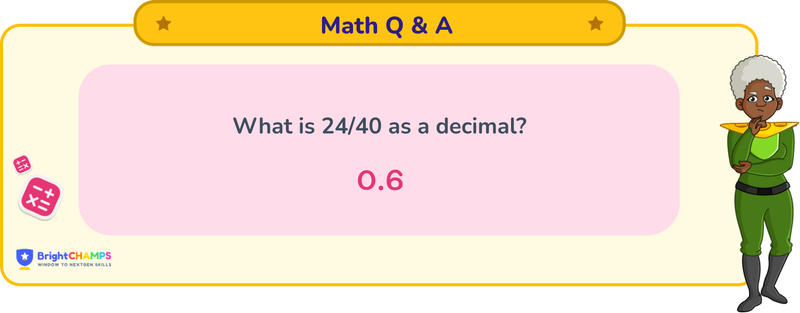
 201 Learners
201 LearnersLast updated on August 5, 2025

24/40 as a decimal

It is a simple question on decimal conversion. Firstly, we have to learn fractions and decimals. A fraction represents a part of the whole. It has two parts: the numerator (number on the top) here, 24, represents how many parts out of the whole. The denominator (number below) shows how many parts make the whole; here, it is 40. A decimal is a way to represent a number that is not whole, using a (.) or a decimal to separate the whole part from the fraction part. The numbers to the left of the decimal point represent the whole, and those to the right represent the fractional part.
What is 24/40 as a decimal?

Answer
24/40 in decimals can be simplified to 0.6.
Explanation
To get 24/40 in decimal form, we will use the division method. Here, 24 is smaller than 40, so we proceed with the division process to convert it to a decimal. Let's see the step-by-step breakdown of the process:
Step 1: Identify the numerator and denominator because the numerator (24) will be taken as the dividend and the denominator (40) will be the divisor.
Step 2: Divide 24 by 40. Since 24 is smaller than 40, the decimal point is added in the quotient place, making it 0.
Step 3: Multiply 24 by 10 to make it 240. Now divide 240 by 40.
Step 4: 240 divided by 40 is 6, so write 6 in the quotient place after the decimal.
Step 5: Since there is no remainder, the division ends here.
Thus, the answer for 24/40 as a decimal is 0.6.
Important Glossaries for 24/40 as a decimal
- Fraction: A numerical quantity that is not a whole number, representing a part of a whole.
- Decimal: A number that uses the base ten and includes a decimal point to separate the whole part from the fractional part.
- Numerator: The top part of a fraction, indicating how many parts of the whole are being considered.
- Denominator: The bottom part of a fraction, showing how many parts make up a whole.
- Simplification: The process of reducing a fraction to its simplest form.




